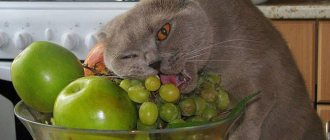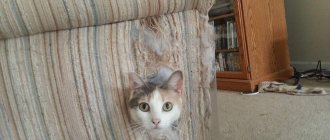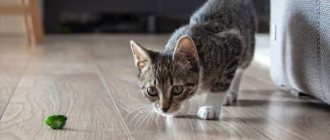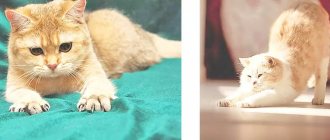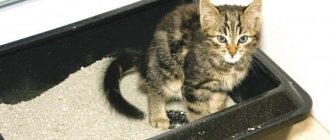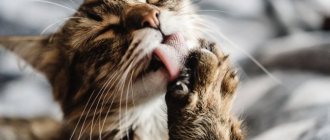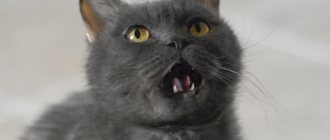Let's say you have a furry pet living in your house and suddenly one or more flowers begin to turn yellow or die for no reason.
Most likely, this cat got into the habit of relieving itself in a flower pot. How to stop a cat from pooping in flower pots? Obeying instinct, cats bury their feces in the ground. Perhaps this happened in your case too. If the suspicions are confirmed, you will have to try to wean your pet from this activity.
Why do cats dig in flowers?
There are several reasons why domestic cats climb on pots of soil and chew green spaces in the house. Here's what experts think about this:
- Lack of vitamins and microelements in the animal’s body. Street cats look for medicinal grass and eat it, which allows the body to obtain the necessary substances. Domestic cats can eat plants in flower pots, which is very unsafe for the animal itself. For example, some types of house plants are poisonous, and if a cat begins to gnaw on such a stem, there is a high risk of severe poisoning of the animal.
- The cat is looking for a convenient place to go to the toilet. For example, the animal does not like the filler in the tray, but the soil in flower pots is very convenient for this matter. The reason for this cat behavior can also be an uncleaned litter box. Keep the cat litter clean and change the litter in it in a timely manner.
- Cats can climb on window sills and damage green spaces solely because of resentment toward their owner due to lack of attention. With this behavior, the cat not only wants to take revenge, but also to draw attention to itself.
It is not difficult to understand the main reason why a cat climbs into flower pots. If an animal digs the ground and relieves itself there, it means that she is unhappy with her cat litter. The cat eats the stems and leaves of plants - its body lacks vitamins. An animal simply spoils flowers in pots, throws them on the floor, chews leaves or breaks branches - a clear sign of a lack of attention on your part.
Cat sleeps in a pot
Domestic cats are rarely allowed to go outside and sleeping in a pot is an opportunity for them to feel in harmony with nature. Pets also love to snuggle up to plants and chew leaves. Some people are attracted by the smell of flowers. As an option, cover the flowers with a net or film and fence them with a wooden mini-picket. As soon as the pet falls asleep in the potty, sprinkle water on it.
Action plan for weaning a cat from climbing into a flowerpot:
- Place special crystals on the ground. As the granules swell, they transform into jelly. The crystals do not affect watering and the plant, but they repel animals.
- Cats love the comfort of sleeping on soft ground. Therefore, you can pour pebbles into the pot (preferably sharp ones). This will create discomfort for the pet, and it will look for another place.
- Cover the ground with cardboard. Sprinkle ground pepper on top. The protection is removed only before watering.
- The ground is covered with several layers of foil. The rustling noise will scare away the cat.
- If the flower is small, cover it with a plastic cake lid. Cut a hole at the top to allow air to enter through it. If the plant is tall, the hole is made so that the trunk and leaves pass through it.
- The ground is covered with paper with double-sided tape glued to it. The pet's paws will stick, and he will try not to approach the “dangerous” place anymore.
- A fence is made around the perimeter of the pot from planks or plastic rods tied with thread or glued with tape. The structure is half immersed in the ground.
- You can scatter pieces of garlic, onion, and ginger around the perimeter of the flowerpot.
- Surround the plant with herbs.
- Sprinkle cotton pads with essential oils and place them on the ground.
Pets like to dig holes and get comfortable in them. This way they can control the surrounding area. A simple method is to make a picket fence from toothpicks or sharp shells and pebbles.
Exploring the world around us
Both children and kittens actively explore their environment. The desire to taste inedible objects, including plants and soil, can lead to negative consequences for your pet. Toxic finishing materials and poisonous flowers often lead to poisoning and death of the animal.
If you notice your cat's increased attention to dangerous objects, you should interest her in new toys or plants specially grown for chewing. You can germinate wheat, oats, and lawn grass in a pot. Edible toys will keep the kitten occupied for a long time and dangerous sabotage will not become a habit.
An animal can also start using a pot with soil as a toilet. Scattered soil and a damaged plant will bring little joy to any owner. Therefore, if you cannot distract your pet from a container with soil, then it is better to move the flowerpot to an inaccessible place.
Causes
Many cats love to dig in pots placed on the windowsill. However, it does not matter where they are installed. The pet can get to the potty no matter where it is. And the animal is, of course, not attracted by the beauty of the flower. He has other reasons why he is so partial to houseplants.
Lack of vitamins
It is possible that the cat is digging the soil in a pot where the owners carefully grow their favorite flower, because its body lacks any vitamins. At the same time, the pet can feel that these same vitamins are located somewhere underground, that is, they are contained in the root of the plant.
The animal itself, of course, does not understand what vitamins are. However, his instinct tells him what food will be good for him. However, it may be wrong. More than once, cats consumed the roots of a poisonous plant, which caused poisoning. Therefore, you should not allow your pet near the flower pot unless you are sure that the plant is absolutely safe. And no one will be happy about damage to the flower itself either.
If a cat needs vitamins found in plants, it is worth planting special grass for it. To do this, you must first buy seeds. You can also use already sprouted grains. Both are sold in pet stores. If you buy a plant there, you can be sure that it will not cause any harm to your pet.
Toilet
In natural conditions, cats use soil as a toilet. This is why they are so attracted to a flower pot filled with soil. At the same time, they ignore the tray provided specifically for them. In this case, the owner should try to find out why his pet categorically refuses to go to the litter box. Let's list the most likely reasons.
- Perhaps the animal simply does not like the litter in the tray.
- If the cat is clean, then it will refuse to go into a dirty litter box.
- The litter box itself can also be repulsive to your pet.
- Or maybe the cat doesn’t go to the litter box just because it’s not installed in the right place. This problem can be solved by rearranging the tray.
Methods to combat the problem
The first thing to do in this situation is to raise the cat and, whenever you try to get close to the flower pots, say loudly “No!”
Observing your pet will give you an answer as to why he does this.
Observe, maybe the cat climbs onto the windowsill not in order to spoil your green spaces in the house, but in order to get closer to the window and inspect everything that is happening on the street. In such a situation, the problem can be solved easily and simply! Remove a couple of peas from the windowsill to create an observation deck for your inquisitive kitty.
If your cat digs the ground and shits in it, try changing the type of litter for the litter box. Did not help? Then use a special spray to repel animals. You can buy it at a pet store.
Traditional methods also work effectively:
- Place citrus peels near the plants, pets cannot tolerate this smell;
- cats also don’t like the smell of garlic, place garlic cloves next to flower pots;
- Cover the window sill with food foil, animals do not like to walk on a rustling surface;
- you can use a spray bottle of water to scare away the cat; water treatments will quickly eliminate interest in walking on window sills;
- flower pots can be lubricated on the outside with “Star” balm or essential oils with strong odors;
- Some are helped by ordinary toothpicks, tightly inserted into the ground with flowers with the sharp side like a “hedgehog”; a couple of unpleasant touches will reduce the cat’s interest in home flowers;
- cover the soil in the pots with small pebbles, they will not harm the plants, but will eliminate the cat’s interest in the filler of the flower pots;
- You can put double-sided tape next to the pots; cats don’t particularly like to walk on sticky surfaces.
If your furry friend eats plant leaves and stems, try planting a pet-specific grass in a pot. You can buy such seedlings at a pet store. Green grass is rich in various vitamins and microelements, which will bring undeniable benefits to the body of your tailed pet.
What to do?
To prevent your pet from encroaching on the plants, it is better to hang them on a flower pot.
- Remove flowers from the animal’s reach: from window sills to high cabinets, shelves, flowerpots or in a separate room where the cat does not have access. If you have a personal plot, the pots can be taken outside, and in the warm season - to a closed balcony.
- Organize a mini-greenhouse, if possible. You can buy a glass box for small plants or make it yourself. This option is especially suitable for owners of succulents: in addition to the practical function, the florarium also has a decorative one.
- Keep the tray clean. You should clean as often as possible, preferably after each cat’s trip to the toilet. Many cats are squeamish, and once they go to the litter box, they will never defecate there again. If the cat refuses to relieve itself even in fresh substrate, replace the filler or try a different form of cuvette.
- Place several trays in different places. This will allow the animal to choose the most comfortable location, and will provide access to a clean tray in the event of a long absence of the owner.
- Keep an eye on your pet. Cats are prone to mischief in the absence of their owners, so if you notice that a cat is climbing into pots, you should splash water on it or scare it off with a sharp sound, for example, clap your hands, shout, and then take it to the litter box.
Plant protection
You can keep the animal away from the pots using toothpicks.
The substrate should be covered with a special net, thick cardboard, a plastic bottle cut in half, or the pot should be wrapped with double-sided tape. After several unsuccessful attempts to reach the ground, the pet will lose interest in plants. Pebbles or pine cones on the surface of the substrate will also help to keep the cat away from the plants. Sharp objects that are unpleasant for the paws will prevent you from climbing into the pot and rummaging in the ground. The pebbles should be quite large so that the cat does not dig them out of the pot along with the soil. Toothpicks or sticks firmly stuck into the ground are also suitable.
You can place lemon or orange peels in pots - cats are repelled by the smell of citrus fruits. In this case, only fresh, smelling zest is effective; dried zest will not do any good. Foil, rustling newspaper or waxed slippery paper spread around the flowers will prevent a timid cat from walking on the windowsill. It’s also worth purchasing a special bio-spray repeller “Antigadin” based on essential oils and spraying “forbidden” places. As a rule, 2-3 sprays per day are sufficient for a lasting effect.
Mental disorders
Pica is a disorder similar in severity to anorexia and bulimia. Expressed in the desire to eat inedible objects. Appears as a result of mental disorder, nervous shock and can lead to death.
Research by scientists on animal behavior has revealed that pets, just like people, are susceptible to depression and fear. Pica in science is divided into two types:
- A common disorder is eating paper, stones, and earth.
- Coprophagia is the eating of feces.
Cats are susceptible to both forms of the disease. In order to determine why a cat eats soil from a psychological point of view, it is necessary to analyze all the facts from the pet’s life.
The problem could begin in childhood, especially for animals picked up from the street at an early age. Starvation leads to death after 3-4 days. Even if the kitten was rescued during this period and provided with the required care, the consequences of the injury may appear several years later. The animal will more often suffer from gluttony throughout its life, and this often leads to the second type of eating disorder - coprophagia.
It is more difficult for a domestic cat to experience hunger, which, due to circumstances, finds itself on the street and is forced to remain without food. Having found a secluded refuge, the pet hides and the feeling of fear blocks the need for food. The pet is paralyzed by fear and prevents it from moving. If the owners manage to find the animal and save it, then recent impressions haunt the shocked person for a long time. Here is another psychological reason why a cat eats soil from indoor pots.
Consequences of eating houseplants
As we have already said, many plants in the house are poisonous species, and after consuming them, the animal may be in real danger. What may be the consequences of consuming poisonous plants:
- prolonged diarrhea in a cat;
- nausea, vomiting, loss of appetite;
- severe dehydration of the body;
- general weakness, coma;
- death.
If you do not want to lose your furry friend, protect him from the following plants in the house: dieffenbachia, caladium, azalea, philodendron, schefflera, chrysanthemum, ivy, cyclamen, etc. If your cat has managed to eat the leaves or stems of poisonous plants, immediately take her to an experienced veterinarian.
Cats look for healing herbs and eat it, help them find it
To bring your animal to the doctor, provide him with first aid to neutralize the effects of dangerous poisons:
- do a cleansing enema with warm water;
- Give your cat a mixture of vegetable oil, egg whites and milk.
Never leave your cat alone with dangerous plants in the house. Better yet, get rid of such plantings if a furry pet has settled in your home.
Be sure to raise your cat from the first days of being in your family. Love, but do not pamper, mark the boundaries of what is permitted. If the animal behaves badly, scold it, but for good behavior you can reward it with your favorite treat.
You need to raise an animal correctly, without involving physical violence in this matter. Only instructive conversations in a strict intonation will allow you to raise an obedient cat with good manners and decent behavior.
Well, many owners are simply lucky with indoor cats who do not show any particular interest in indoor plants. If your pet is more inquisitive and has already managed to get into trouble on the windowsill, use the above methods to deal with the bad behavior of your four-legged friend.
How to protect indoor plants when you take a kitten into your home?
It is easier to prevent the occurrence of this problem than to later wean the kitten from climbing where it should not. To prevent your baby from thinking about climbing into a container with a houseplant, you need to properly organize his latrine.
It’s not enough to equip your pet with a latrine; you need to teach him how to use it. Having noticed that the kitten is showing increased interest in a houseplant, you need to immediately switch its attention by sharply clapping your hands, quietly slapping your palm on the back, or spraying it with water. Perhaps he will not immediately understand what they want from him. After the pet is driven away from the flower several times, he will be able to understand that there is a cause-and-effect relationship between approaching this object and punishment.
Source
The dangers of the home garden
Indoor flowers can pose a major threat to a cat's health. The poison contained in plant sap can cause serious damage to your pet:
- cause stomach upset and cramps;
- create intestinal obstruction;
- provoke allergies;
- burn the mucous membrane;
- lead to disruption of organ function.
Cats should not eat flowers such as:
- Kalanchoe;
- violets;
- lilies;
- orchids;
- hydrangeas;
- azaleas;
- spathiphyllum;
- begonias;
- chrysanthemums;
- lilies of the valley;
- daffodils and other types of plants.
We suggest you read: Is it possible to give rice to a cat?
Which plants are dangerous for pets?
There are quite a lot of houseplants that are harmful to the health of cats, and in order to cause gastrointestinal disorders and other troubles, pets don’t even need to taste the flower - it’s enough for the juice or pollen to get on the fur or skin. Of particular danger are azalea, dieffenbachia, cyclamen and other flowers, loved by many breeders of cats and other animals.
The beautiful poinsettia is deadly to cats
Table 1. Houseplants harmful to animals.
| Plant | Harmful parts of the plant | Why is it dangerous? |
| Azalea | All parts of the plant | Includes an alkaloid that has a depressant effect on the activity of the central nervous system, causing vomiting, drowsiness, swelling of the throat, convulsions, |
| Scheffeler | Leaves | The juice of the plant has a toxic effect not only on animals, but also on people, and contributes to irritation of mucous membranes and the development of allergic reactions, including Quincke's edema |
| Diefenbachia | ||
| Cyclamen | Stems and leaves | Causes serious poisoning and intoxication, and in case of overdose (if the animal eats too much of the plant) it can be fatal |
| Chrysanthemum | Leaves | A small amount of greens eaten leads to mild illness, a large amount leads to serious poisoning. |
| Almost all climbing plants, especially ivy | ||
| Philodendron | Flowers, leaves | Toxic chemical compounds that are part of greens are a strong allergen that can cause anaphylactic shock. A small amount of juice, if ingested, disrupts kidney function and can lead to chronic dysfunction of the urinary system. |
| Caladium | ||
| Monstera | Leaves | The leaves of a huge palm tree have small needles that cause a strong burning sensation, and in cats sensitive to allergens, they can provoke unwanted reactions in the body. |
| Representatives of the euphorbia family (croton, euphorbia, akalifa) | All parts | Such plants contain a component called euphorbin, which disrupts the functioning of many organs and systems - ulcers and skin lesions that do not heal for a long time, inflammatory processes in the mucous membranes of the mouth and eyes, which can lead to complete loss of vision, disruption of the digestive tract and CNS |
| Flowers of the Kutrov family (oleander, adenium, pachypodium, allamanda) | All parts | The juice of kutrovye plants contains components that contribute to disruption of the cardiovascular and nervous systems. |
| Ficus | All parts | Causes oral irritation and dermatitis |
| Narcissus | All parts | They provoke poisoning of the body, accompanied by the following symptoms: disturbances in the functioning of the stomach, cramps, muscle and abdominal pain, and in case of serious complications - dysfunction of the lungs, heart, kidneys |
| Physalis | ||
| Asparagus | ||
| Lily | Leaves and flowers | Contributes to swelling of the mucous membranes, loss of coordination of movements, dysfunction of the cardiac system |
| Hydrangea | Flowers | The chemical composition of hydrangea contains cyanide, which causes urinary and cardiovascular problems. |
Cacti, including small ones, are also considered potentially dangerous for cats - curious animals can injure their tongues or paws on their spines. Do not forget that not only indoor flowers, but also ordinary street flowers are potentially harmful to the cat’s body. In addition to the natural poisons and toxins found in many plants, chemicals used in specialized stores to make flowers last longer and grow better can harm a cat’s health.
In addition, if an animal drinks water from a container where flowers have been standing for a long time, it may experience an upset stomach and other unpleasant symptoms - microbes quickly multiply in the liquid, which, when swallowed, enter the cat’s body.
It’s also better to keep cacti away from cats.
Many plants that can cause poisoning and serious illness in cats are unpleasant to the taste and burn the mouth, so pets rarely eat large quantities of leaves or flowers. But even a small dose of the toxin can cause unpleasant consequences and symptoms that require consultation with a veterinarian.
Attention! Many indoor plants that are dangerous for cats can also harm people (especially small children), so not only pet owners, but everyone without exception, should be careful when choosing flowers.
Why do they do this
Animals of any gender and age can shit in the wrong place. Experts say that most often an unpleasant situation arises not because of the cat’s poor upbringing or character, but because of health problems or as a way of realizing instincts and natural needs. Pets go out of place because:
- They are not satisfied with the location of the tray in the apartment. You need a fairly secluded place away from prying eyes. If something constantly distracts and bothers your cat while visiting the toilet, he can choose another corner or the owner’s sofa for this.
- The tray is too small or has a strong smell of detergent. The cat is uncomfortable in such a toilet and, not wanting to experience discomfort, she looks for another place.
- It is possible that the animal does not like the look of the filler. The range of these products is now wide, try changing the filler to some other one, this may solve the problem.
- Tray not removed on time. Cats are big cleaners and if their litter box is filled with excrement, they may refuse to use it. If you are away from home for a long time, it is better to put another tray so that the degree of contamination of the cat litter is not excessive.
- The cat has changed its place of residence or has experienced stress. In the first case, the animal may simply not yet get used to the new place, and in the second, it expresses its feelings in this way.
- Infection with worms, intestinal and genitourinary diseases can cause pain in a cat when defecating. In this case, the pet will associate the litter box with causing pain and he will avoid going to the toilet. In this case, only a visit to the veterinarian and further therapy will help.
- After all, cats may simply be marking their territory. They will visit the litter box, but at the same time they leave marks and odorous puddles throughout the apartment. The situation will be corrected by castration or free walking, during which the pet will find a sexual partner.
What to do if an animal shits in flowers?
If your four-legged pet goes to the toilet in a pot with a houseplant, the methods listed will not help wean him from this habit. He may stop approaching the flower and start shitting somewhere else. To solve this problem, you need to eliminate the reason why your pet does not go to the litter box. To do this, you should analyze the following points:
- The material from which the tray is made. Most products are plastic. However, plastic is different from plastic. When purchasing a device, don’t be shy about smelling it. A quality product should not have a strong smell.
- Filler. Some cats like large kibble, while others like small kibble. Smell is also important. Sometimes replacing the litter can solve the problem of the tray being ignored.
- Tray dimensions. It must match the size of the animal. If the pet is cramped in it, it will begin to ignore it.
- Tray location. It should stand in a secluded place so that nothing distracts the pet from visiting it. You cannot place it near the feeder and drinking bowl. A clean cat will not tolerate such a neighborhood.
- Frequency of cleaning the tray. You need to clean it immediately after your pet uses it, or at least once a day.
Lack of essential enzymes
- Take a closer look at the behavior of the animal, unless this feature worsens with the onset of spring, then you can say that the cat, most likely, don’t drink - I don’t want useful compounds. Simply put, the animal suffers from vitamin deficiency.
- This will especially indicate that the cat is happy to eat store-bought regolith. This composition contains many valuable compounds. Bavaria is enriched with fertilizers. As a result, the cat tries to replenish the elixir of life it needs.
- Most often, animals suffer from a deficiency of phosphorus, calcium, sodium and potassium. In this case, it’s a good idea to carefully create a diet so that the cat stops eating soil. Besides this, some cat owners claim, what is it? An animal may experience a deficiency of certain elements due to eating a large amount of meat.
- The problem is that such a product flushes calcium from the body in large quantities. As a result, the animal may suffer from the development of rickets or osteoporosis. In any case, unimportant (= unimportant) is worth waiting for something. Be sure to seek help from a specialist.
- It is strongly recommended to refrain from starting to give your pet various microelements and a synthetic elixir of life on your own. It is the responsibility of the veterinarian to prescribe a special diet and prescribe certain nutritional supplements.
- In order for your cat to fully receive the vitamins it needs, you can germinate oats, peas, wheat, rapeseed and barley on your own. As an alternative, you can buy special grass for cats at the pet store.
- The cause of an animal’s unusual addiction may be the development of anemia. Kittens can suffer especially from this pathology. An unpleasant disease develops due to active growth. The disease can be recognized by the pale tint of the mucous membranes. That's all, general lethargy and bradycardia appear.
- To confirm the diagnosis, you have to take the animal to the clinic so that the doctor examines the blood. This way you can find out about the level of gonad content. If anemia occurs in the acute stage, it will need to be treated with serious injectable drugs.
The kitten shits everywhere except the litter box
A kitten is a special case. When a kitten shits in the wrong place, this is a slightly different situation. Usually, babies are taught to use the litter box and many other things by their mother. But a cat is not always a good mother. Young, inexperienced cats can teach their kittens little, and sometimes even refuse to feed them breast milk.
Kittens quickly master the science of behavior in an apartment
If the cat has not done this, the breeder must accustom the kitten to the litter box. Babies grasp everything on the fly, and if they are regularly placed in a tray after eating and sleeping, the kittens quickly master this science and no longer shit anywhere. But sometimes the kitten is taken to another house when it is very young, or your apartment has too many rooms in which it is easy to get lost.
Having brought your baby to you, stay at home with him for the first few days. It is better to limit access to most rooms and put the kitten in the toilet as soon as he squeaks, shows anxiety, and immediately after he has eaten and slept. Two to three days will be enough for the cat to learn where he needs to relieve his needs.
Only if these rules are not followed can it happen that the baby will shit anywhere. After all, if you do not persistently show him where the toilet is, he will choose this place for himself, and maybe more than one.
Curiosity and Attention
Life in a closed space with constantly busy owners is boring and monotonous. A sedentary lifestyle involuntarily forces the cat to look for entertainment among what is found within its reach. Hanging flat leaves, swaying at the slightest movement, arouse great interest. In the rush of a gaming mood, it’s difficult to resist tasting the plant. If your cat lacks your attention, he can attract it in the following ways:
- there are flowers;
- relieve yourself if the size of the pot allows;
- dig up the ground;
- throw pots on the floor.
We invite you to familiarize yourself with: Ussuri cat tabby exclusive
If the cat doesn't poop in the potty
The cat does not always use the flower pot as a toilet.
The cause may be a deficiency of microelements and vitamins. Outdoor cats replenish them by eating grass and roots. Pets try to chew on indoor plants and soil. You can correct the situation by adding the necessary vitamins and minerals to your pet’s diet and providing it with high-quality dry food. Even if the cat does not use the flowerpot as a toilet, it can tear up the soil and gnaw the stems - then the plant will die. You can scare away your pet using sprays.
Contains orange essential oils:
- "Anti-scratch";
- "Antigadin";
- "Beaphar Cat Fernhalte."
The smell alone irritates the mucous membrane, and once on the tongue, the product burns the receptors. Sprays are safe for people and harmless for children. The pot can be sprayed inside and outside. After a day or two, the procedure must be repeated - otherwise the smell will disappear. However, if your pet is allergic to a specific ingredient, then such products cannot be used.
How to stop a cat from crapping in the apartment yourself
Use the following simple tips to correct the situation when your cat shits:
- Experienced owners who have raised more than one cat claim that it will never defecate where it eats food. If you find a place where a cat or kitten regularly poops, place a bowl of food there, or scatter food nearby on a piece of paper.
- Some people suggest scaring the animal. As soon as you catch your cat doing something bad, spray him with water from your hand or from a spray bottle. The fear he has experienced will discourage him from crap in this place. You can also knock loudly nearby with a rolled-up newspaper.
- Give the animal more attention. Perhaps the cat is simply bored without you or is experiencing stress from the appearance of a small child or another animal in the house. Your task is to create a feeling of comfort and safety for him, then the cat will not urinate on your carpet and on your things.
It is useless to poke the animal’s nose into its piles or puddles; this will not help wean the cat from a bad habit. Cats do not tolerate violence and instead of the desired effect, you risk getting the opposite result. Your pet may forever lose trust in you and become angry, but he is unlikely to understand his guilt.
Cat playing in the potty
If cats don’t have toys or don’t like the ones they have, they can use plants for these purposes. Pets trample their leaves, trunks, and gnaw on twigs. Pets are also attracted to pebbles and jewelry (for example, beads). Little kittens, once in the house, begin to study it. They may play with unfamiliar objects (for example, flowers) or begin to mark their territory.
Sometimes it seems that the cat is playing with the plant when he hits it with his paw. However, this can be a manifestation of aggression if the animal is disgusted by the smell of flowers or senses the mark of another pet. Then the cat will not stop until he breaks or digs up the plant. In this case, the flower must be moved to a place inaccessible to animals. But there should be no curtains nearby (they are easy to reach the plant).
What to do if a cat eats soil?
Diagnosis and treatment
In such a situation, the pet will benefit from hair removal paste. If there is a perverted appetite, the owner should take the animal to the veterinarian. If there are symptoms characteristic of diseases, the doctor prescribes x-rays, CT or MRI, general and biochemical blood or urine tests, and stool examination for worm eggs. The treatment regimen is determined by the doctor depending on the examination results. Self-medication is prohibited. Antibiotics or antiviral drugs, vitamin-mineral complexes, and immunomodulatory agents are prescribed. It is recommended to introduce special food and paste into the diet for removing hair.
Aids
Sometimes it is worth using additional means to solve the problem of getting rid of unauthorized puddles.
- An animal experiencing stress can be given calming drops based on natural ingredients, purchased from a veterinary pharmacy.
- If the animal is overly excited by unrealized sexual instinct, and you cannot use castration for some reason, purchase special contraceptives for cats, for example, Gestrenol. Just keep in mind that long-term use of such drugs is not advisable - this can cause disruptions in the hormonal system. Over time, it is still better to neuter your pet.
- On sale you can find special repellents in the form of a spray (Gimpet, Himola Antigadin). They are used to treat the places where the cat has soiled itself and, according to the manufacturers, this will discourage the cat from shitting there again.
- A simple, cheap remedy – table vinegar – will also help. It is necessary to first clean the floor in the place where the cat pooped, and then wipe it with a piece of cloth soaked in vinegar, or spray the product from a spray bottle. The cat will avoid such a strong smell.
- Some people use bleach or ammonia to repel the smell, but be careful, not all surfaces can be treated with them. So, dark linoleum or parquet can easily be ruined by bleach, which eats away the paint. For upholstered furniture, for the same reason, it is better to use specially designed commercial sprays that will not harm it.
If a cat shits in a flower pot, it is better to put the pots that the cat likes in an inaccessible place: on a shelf or glass balcony, or a special flower stand. You can organize protection directly in the pot by placing chopped lemon or garlic slices on the surface of the soil.
As an option, you can purchase a mineral filler for the tray, this will allow the animal to squirm around there to its heart’s content and realize its instincts. As you can see, there are quite a few ways. Try the ones that seem most suitable to you. Something will definitely help stop your cat from shitting anywhere.
